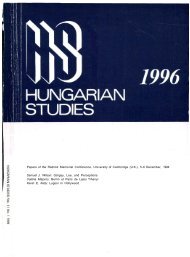The Canadian-American Review of Hungarian Studies - Vol. 4 ... - EPA
The Canadian-American Review of Hungarian Studies - Vol. 4 ... - EPA
The Canadian-American Review of Hungarian Studies - Vol. 4 ... - EPA
Create successful ePaper yourself
Turn your PDF publications into a flip-book with our unique Google optimized e-Paper software.
limitations <strong>of</strong> Bowring and others: their inability to overcome the "becsispanyolfal, amelyre 'Mikosch' vagy 'Ungar Janosch' torzkepe voltrafestve." 6 Bowring had to depend on Carl Georg Rumy, Ferenc Toldyand finally, on Karl Maria Kertbeny for his information. Not knowingany <strong>Hungarian</strong> himself, he used the German anthologies published bythese men, or he obtained German versions <strong>of</strong> <strong>Hungarian</strong> songs. Sincethese sources were not critical in their selections, and since the Germantranslations were <strong>of</strong>ten inaccurate, Bowring and the others formed adistorted picture. Admittedly, the exoticism <strong>of</strong> <strong>Hungarian</strong> literature,real or imagined, was emphasized in the English versions. This is whatthe readers expected, and this is what they were given. As Hankiss hasstated, "A muvelt kiilfoldi ragaszkodik a magyar taj idilli zartsaganak,ember es fold szoros osszetartozasanak foltetelezesehez." 7As early as 1827 Bowring published one <strong>of</strong> Sandor Kisfaludi's "folksongs"in the May issue <strong>of</strong> the Monthly <strong>Review</strong>. Undoubtedly, he wasworking from one <strong>of</strong> the many German anthologies or periodicals thatcarried numerous examples <strong>of</strong> the suddenly popular "Magyar" folksong.Later. Bowring turned to Georg Rumy's Magyarische Antho/ogieas a source. It is ironic — and was unfortunate for the acceptance <strong>of</strong><strong>Hungarian</strong> literature in Western Europe — that these sources representedthe "distortions" rather than the true poetry <strong>of</strong> Hungary. <strong>The</strong>yemphasized the sentimentality and exoticism <strong>of</strong> Pre-Romanticism at atime when both <strong>Hungarian</strong> writers and European tastes had progressedbeyond this. Consequently, while Pet<strong>of</strong>i and his friends fought againstthe cheap success <strong>of</strong> unrealistic and sentimental verse, it was preciselysuch poems that became known abroad as <strong>Hungarian</strong> literature.<strong>The</strong> ambiguous or divided response to <strong>Hungarian</strong> literature canperhaps best be illustrated by the reactions to specific works. Bowring'sPoetry <strong>of</strong> the Magyars, for example, received generally good reviews.<strong>The</strong> quality <strong>of</strong> the translations was uneven, the selection was stronglyinfluenced by popular taste, but the introductory essay on the Magyarlanguage and the estimate <strong>of</strong> <strong>Hungarian</strong> literature was surprisinglyaccurate. Yet, though interest in the book was lively enough, it failed tohave any real impact. This occurred chiefly, 1 believe, because enthusiasmfor things <strong>Hungarian</strong> was mostly emotional, based on Englishsympathies for the Revolution <strong>of</strong> 1848 49. Such emotional commitmentshad a counter-effect, too: Frazer's Magazine, departing from thegeneral trend <strong>of</strong> eulogy, published a review slanted at least as severely inthe negative direction which illustrated its thesis by citing garbled lettersequencespurporting to be the <strong>Hungarian</strong> text. 8 Similarly, the Athenaeumdisplayed prejudice or at least ignorance when it spoke <strong>of</strong> Janos
















